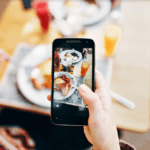There is no tool more powerful than storytelling, and Rob Walker wanted nothing but to prove it. In 2009, he bought several objects from eBay and asked 100 creative writers to invent stories about $128.74 worth of items to see if the stories can transform insignificant objects into significant ones. In case you’re wondering how the storytelling experiment went, the net profit from the sales of the items was $3,612.51.
Take the globe paperweight as an example, originally bought for $1.49, and sold at $197.50 when the story was added. Why? Because the story resonated with the buyer, it became significant to someone. It all comes down to your emotional investment. The more emotionally invested you are in anything, the less critical and objectively observant you become.
The greatest emotional investment of all is falling in love, and falling in love resembles a good story.
In stories, 3 hormones can be released:
- Dopamine
- Oxytocin
- Endorphin
High levels of dopamine tend to enhance concentration and boost memory and motivation. Have you ever wondered why Alfred Hitchcock’s films are still even discussed? They are so notorious because he creates suspense. The same applies to your storytelling technique – you need to launch a cliffhanger.
Yet, the most beautiful thing is that stories are, by definition, dopamine generators because people always expect something to happen. Furthermore, whatever character you decide to build within your story, you create empathy, and oxytocin is the most beautiful hormone of all because it makes you feel human. Its effects lead to increased generosity, trustworthiness, and bonding.
Along with dopamine and oxytocin, laughter is one of the easiest ways to induce endorphin release. Your audience will then become more relaxed and focused, feeling positive. Basically, you have the power to pick the story you want to tell and release the hormone you wish in the person you’re talking to to achieve exactly the desired effects.
How can these facts help your business, you might ask. Well, every business has a story to tell, including yours. But how can you develop it at every stage in order to improve your sales performance?
We will focus on this particular question and explore your opportunities to differentiate your restaurant in a crowded marketplace.
A business without a visual storytelling website is a brand without a face
Every story has a beginning, and the beginning of your story starts with your website, so make sure you set the scene by providing that great first impression.
Customers want to know you and the real story behind why you do what you do. Bill’s website is able to instantly set the right scene. Just take a look at how they are telling their story in less than 30 seconds.
Bill’s has the right beginning that gets you to stick around, inducing oxytocin and thus creating a bond between the site and its visitors.
Usually when we access a certain website, we leave without going past the landing page. Yet, if we are given a good story right from the start, we’ll have to stick around just to find out what happens.
Brand-building: the story of telling
The heart of every story is its main character. As you go through the beginning of a story — in our case, scrolling through a website — you get acquainted with the character, the superhero: the company’s brand.
People like to buy from authentic brands that empower their beliefs and demonstrate their trustworthiness. Your audience needs to know where you come from.
High Brew Coffee’s website does that successfully. They tell their story so that their audience gets to know and connect with them instantly.
Sure, not everyone can proudly say that their business idea came while exploring the Caribbean islands. Yet, your story, no matter how uninspiring it might sound, is still interesting enough to share because it’s yours.
Nobody else will have the exact story as you, and that’s what makes it unique. Your brand’s story is uniquely yours. So, let your audience know where you come from, and let them connect with you.
People buy brands, not products
The secret is, there is no secret. Stories move people to take action. If your business is more than your products or services, you will touch customers’ hearts in some way.
This infographic shows exactly how storytelling is helping businesses boost their sales. The sooner you stop hiding behind your products and you decide to humanize your brand, the better.
The good news is that this applies to restaurants, hotels, non-profits, and basically to any type of business. There are many different ways to tell your brand’s story online.
Takeaways
Rob Walker’s storytelling experiment, along with the study conducted by Origin/Hill Holliday on telling tales, proves that storytelling works for any business that wants to increase its sales.
Begin your story by setting the right scene right from the start, e.g., your website. Then, tell your story with design and wrap it around your character, e.g., your brand.
As you do this, pay attention to the hormones (dopamine, oxytocin, endorphin) you want to use to trigger your customer’s emotional investment.
The truth is that your story and your design belong together. Planning your story with design involves understanding your audience and some web design theory.
Author Bio: Dishan Jay is the founder of DG Studio, a Los Angeles-based digital agency that develops beautiful websites and apps and executes marketing strategies plus storytelling and design techniques around them.







